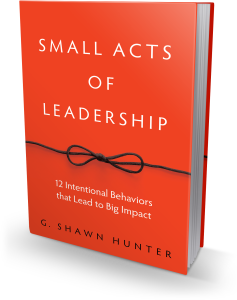Three Ridiculous Myths About Leadership
This article is excerpted and edited from my new book, Small Acts of Leadership. Enjoy!
As one of the most revered coaches in American history, John Wooden, the “Wizard of Westwood,” coached his University of California basketball team to an unprecedented ten national championship titles in twelve years. This remarkable winning streak included an astonishing run of eighty-eight undefeated games in a row, and back-to-back 30–0 seasons.
If you had been lucky enough to play basketball for the great John Wooden in the 1960s and early 1970s, you would have been surprised on your first day of practice. Instead of the opportunity to show your passing, shooting, and dribbling skills in front of the esteemed coach, your first lesson at your first practice would have been to learn to put on your socks, and lace and tie your shoes, properly.
Describing the first practice of every season, Wooden would ask his players to take off their shoes and socks. Explaining that these were the most important pieces of equipment each player possessed on the court, Wooden taught his players how to carefully pull on each sock, making sure there were no wrinkles, particularly around the heel and toes, which might cause a blister.
Then, advising each player to hold his socks up firmly while lacing his shoes, he told the player to pull the laces securely from each eyelet, not simply yank the laces from the top. And always, always, double-knot the laces, Wooden said, having no tolerance for shoes that became untied during a practice or a game. Ever.
This is how the greatest basketball coach of all time started his first practice of each season. Leadership isn’t about how to put on your shoes and socks, but it is about doing little things that can lead to big impact. Small, consistent efforts, practiced over time, can yield big results for you, and the people around you.
Here are three of the biggest myths of leadership that simply are not true, yet are constantly shared and reiterated over and over.
Great Leaders Possess Great Confidence.
Stanford University is one of the greatest academic institutions in the world, and every year it produces some of the finest leaders. To get into Stanford requires not simply good grades, but also a record of demonstrating leadership, ingenuity, community service, and an aptitude for continuous learning.
Each year, Olivia Fox Cabane, who teaches at Stanford, asks her incoming group of freshman, “How many of you in here feel that you are the one mistake that the admissions committee made?” Each year, more than two-thirds of the students raise their hands.
Academy Award winner Jodie Foster told an interviewer on 60 Minutes she feared she would have to give her Oscar back after winning best actor award for her role in The Accused. “I thought it was a fluke,” she said in the interview.
Meryl Streep has been nominated for more Academy and Golden Globe awards than any other actor in history. She told the documentary film maker Ken Burns, “You think, ‘Why would anyone want to see me again in a movie? And I don’t know how to act anyway, so why am I doing this?”
Pressure often creates stress. In a typical stress response, heart rate and breathing increase, and blood vessels constrict. But those people who rise to challenges with the belief that stress is a positive opportunity have an opposite physiological response: the blood vessels open and relax as if they were in a state of elation or preparation for physical test.
Embracing adversity and challenge with a positive mindset is another way of saying that you trust yourself. It’s another gesture of confidence. And that confidence and resolve will make you much more resilient for whatever challenges arise. That’s the first secret of great leadership.
Middle Management is a Becoming Irrelevant
This myth has been propagated as recently as April, 2016 by Josh Bersin who writes:
One of the senior execs I talked with the other day told me “I don’t have time for mid-level managers any more. I can get the information I need to run my business through our digital information systems. If our leaders aren’t hands-on experts in their business areas, I don’t really need them.”
I disagree. Middle managers are the cultural lifeblood of organizations. They guide the mood of the organization, attract and retain top talent, and become the lens through which every employee sees the company. They also serve as an interpreting bridge between individual contributors and executives. If they are good, managers provide context, tone, and cultural glue.
In an interview with Tom DiDonato, Senior Vice President for Human Resources for Lear, a global technology and innovation company, he told me:
Ultimately, people view the company through the lens of the person they work for. They don’t say “I work for Company XYZ, and even though my boss, and their boss, aren’t role models for me, I really love the company.” I doubt you will ever hear that. . . . If you view your boss as a role model, you probably think really well of the company. I believe that to my core. That’s the one thing you don’t have to tweak. . . . Keep getting great leaders. Keep developing great leaders. Keep having those people in your company that others view as role models, and you’ll have that sustainable culture that attracts the kind of talent that everybody is vying for.
Leaders Can Always Recognize Wrongful Behavior
The term “deviance” has long been associated with behavior that is harmful, dangerous, or perhaps immoral, such as lying, cheating, stealing, and other dishonorable acts. But sometimes organizations slip into unethical behavior, and going against the norm in a positive way, through “positive deviance”, may be more honorable behavior.
“The culture of any organization is shaped by the worst behavior the leader is willing to tolerate,” – Steve Gruenert and Todd Whitaker
Earlier in 2016, the fallout from the Volkswagen deceit reached global proportions. The systemic deception by Volkswagen has been called the “diesel dupe.” As a BBC News article explains, Volkswagen was found to have installed a device that defeated emissions testing, effectively changing the performance results of the emissions tests on its diesel vehicles. This “defeat device” was actually a piece of software designed to recognize when the vehicle was undergoing emissions testing by recognizing test circumstances. VW has admitted to installing this device on eleven million cars worldwide.
Beyond the mechanics of the deceit and the politics of the scandal lies the question, “How could the people and the culture within Volkswagen have permitted this?” The device was too integrated and sophisticated to have been a mistake produced by lack of oversight, confusion, or even ineptitude. The device, and the deceit, had to be carefully engineered and intentional. But were the engineers working on the software truly aware that they were committing an unethical act?
Daniel Donovan, an information technology engineer in Auburn Hills, Michigan did recognize that Volkswagen was doing something very wrong, and he filed a lawsuit against Volkswagen after they terminated him for attempting to reveal the truth.
Diane Vaughan is a social scientist who coined the term “normalization of deviance” to describe the way organizational cultures can begin to drift morally and rationalize that drift over such a slow time horizon that they aren’t even aware of it themselves. Rather than being positive, this kind of deviance is destructive.
As she wrote about in her book The Challenger Launch Decision, Vaughan studied the infamous 1986 Challenger space shuttle explosion and discovered that faulty O-rings, linked to the disaster, were identified as fallible long before the disaster occurred, they were simply tolerated as an acceptable flaw in the design.
“No fundamental decision was made at NASA to do evil,” Vaughan wrote. “Rather, a series of seemingly harmless decisions were made that incrementally moved the space agency toward a catastrophic outcome.” The O-ring damage observed after each launch was normal. The culture had simply drifted to a state in which that condition was also considered acceptable.
In the NASA example, the existence of the damaged O-rings after each launch was deemed acceptable. It became an implicit, and accepted, rule that everyone simply tolerated and believed to be quite normal. But if we step back for a moment and study the situation, as Vaughan did in her analysis, that acceptance of damaged O-rings seems pretty crazy.
Only a day before the fatal launch of Space Shuttle Challenger, engineers Bob Ebeling and Roger Boisjoly strenuously argued to NASA officials that the O-rings could stiffen and fail to properly seal the joints of the booster rockets because of the cold January temperatures. These arguments were not persuasive to NASA officials because, after all, they had the original detailed engineering report stating that the risk was acceptable.
The lesson is that the greatest leaders know what they don’t know, and seek out the truth from all corners of the organization.
Edited and excerpted from Small Acts of Leadership with permission from Taylor and Francis Group Publishing. Copyright 2016. ISBN-13: 978-1629561363
- ____________________________________________________

Twitter: @gshunter
Say hello: email@gshunter.com
Web: www.shawnhunter.com



